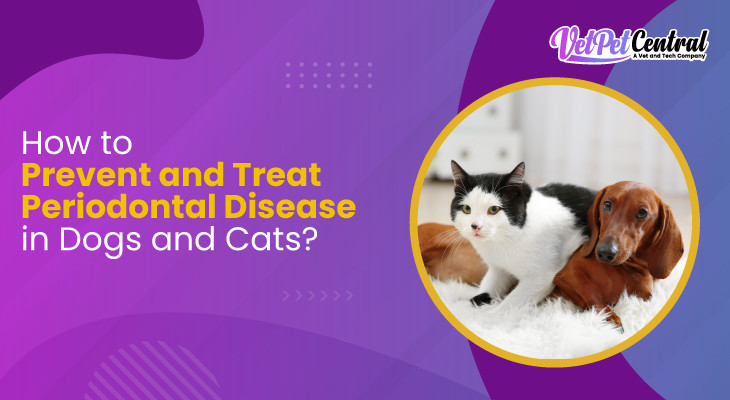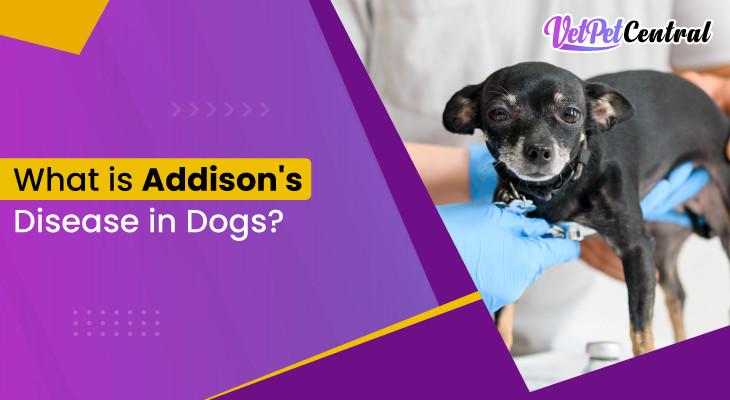How to Prevent and Treat Periodontal Disease in Dogs and Cats?
 Jan 24, 2025
Jan 24, 2025

Like humans, pets are also susceptible to dental diseases. They are comparatively more interested in confronting their teeth on everything amazing they see.
Periodontal disease is a common problem in both canines and felines. Over 75% of dogs and cats older than four years have periodontal disease.
This blog will discuss in detail:
- How to prevent periodontal disease in both canine and feline
- Potential causes
- Stages of the periodontal disease
- Common treatment options
- How to find a reliable veterinarian
How does Periodontal Disease actually develop?
It begins with developing a fluid composed of germs, sloughed cells, and protein, which we get rid of by brushing our teeth.
When plaque is left unchecked, it combines with the mineral salts in food to produce dental calculus or hard tartar.
Calculus upsets the mouth's acid-to-alkaline balance, fostering the growth of germs. These bacteria's byproducts "eat away" at the tooth until the tooth falls off. Read guide on how long can pets teeth stay safe from periodontal disease and learn more.
Periodontal Disease in Dogs
Let’s dive into the details!
What Is Periodontal Disease in Dogs?
This is a condition that impacts the tissues of the oral cavity and the supporting structures of the teeth mounted in them.
This process starts with forming a sticky film of bacteria that hardens to tartar formation on the teeth.
It can lead to gum reddening, infections, and, as you may well know, tooth loss where regular care is not practiced.
Read more about how to manage dental diseases in dogs from this guide.
Periodontal Disease in Dogs Stages
Periodontal disease progresses in the following stages:
Gingivitis (Stage 1):
Inflammation of the gums due to plaque buildup.
Early Periodontitis (Stage 2):
The plaque turns into tartar, causing gum sensitivity and bleeding.
Moderate Periodontitis (Stage 3):
The infection spreads to supporting tissues, leading to bone loss.
Advanced Periodontitis (Stage 4):
Severe damage to the teeth, bones, and gums occurs, resulting in tooth loss.
What Causes Periodontal Disease in Dogs?
Below are the common factors that result in periodontal disease in canines.
Poor Oral Hygiene:
- Lack of regular brushing allows plaque to harden into tartar.
Diet:
- Foods high in sugar or soft consistency promote plaque buildup.
Breed Susceptibility:
- Especially small breed dogs are more prone to gum disease due to their crowded teeth.
How to Prevent Periodontal Disease in Dogs
Below are the best ways to prevent periodontal disease in dogs:
1. Brush Your Dog’s Teeth Daily:
- Use dog-specific toothpaste for safety.
- A soft-bristled brush effectively cleans without damaging gums.
- Establish a routine to make it a daily habit.
2. Offer Dental Chews:
- Provide dental chews designed to reduce plaque and tartar.
- Look for products approved by veterinary dental associations.
- Chewing helps mechanically clean teeth and freshens breath.
3. Feed a Dental-Friendly Diet:
- Choose kibble that promotes oral health through mechanical cleaning.
- Food should be ingredient-rich to help remove plaque and tartar.
- Avoid serving repeated soft foods.
- Provide chewable foods.
4. Schedule Regular Vet Check-ups:
- Professional dental cleanings should occur at least once a year.
- Regular check-ups allow early detection of dental issues.
- Discuss any concerns about your dog's dental health with your vet.
5. Use Dental Rinses:
- Add water additives to reduce bacteria in your dog’s mouth.
- Look for products specifically formulated for pets.
- Use rinses as part of a comprehensive dental care routine.
6. Provide Fresh Water:
- Ensure your dog has access to clean, fresh water at all times.
- Proper hydration helps maintain oral health and flushes food particles.
7. Monitor Oral Health:
- Regularly check your dog’s mouth for signs of dental issues.
- Look for bad breath, swollen gums, or loose teeth.
- Report any changes to your veterinarian promptly.
Treatment for Periodontal Disease in Dogs
Treatments are necessary when the disease crosses the stage mentioned above.
Visiting a veterinarian may be a viable option to fix the issue and ensure perfect eating for your furry friend.
Here are the common treatments:
1. Professional Dental Cleaning:
- Done under anesthesia for detailed cleaning.
- Removes plaque and tartar from (above and below) gumline.
- Prevents progression of disease.
- Ensure a thorough dental examination.
- Prevents tooth loss and improves oral health.
2. Tooth Extraction:
- Necessary for severely damaged or infected teeth.
- Done under anesthesia for the dog's comfort.
- Prevents complications like abscesses or bone loss.
- Reduces risk of infection spreading.
- Relieves pain and improves quality of life.
3. Antibiotics:
- Controls bacterial infections and inflammation.
- Prevents secondary infections after procedures.
- Used alongside other treatments like extractions.
- Reduces gum pain and swelling.
- Must be given as directed for effective recovery.
4. Root Planing and Scaling:
- Remove plaque below the gums.
- Smooths tooth roots to reduce bacteria buildup.
- Helps gums reattach for better support.
- Can prevent tooth extraction in some cases.
- Improves gum health and prevents disease progression.
5. Gum Surgery:
- Needed for severely damaged gum tissue.
- Removes diseased tissue to promote healing.
- Reduces deep pockets that harbor bacteria.
- Stabilizes teeth by repairing gum tissue.
- May involve grafting healthy tissue for recovery.
Periodontal Disease in Cats
What Is Periodontal Disease in Cats?
In cats, plaque forms on their teeth, which leads to inflammation of the gums and disrupts the general health of the teeth.
If not controlled, it leads to tartar formation and causes gum infections and tooth loss.
Feline Periodontal Disease Stages
Periodontal disease in cats progresses through the following stages:

Causes of Periodontal Disease in Cats
See the below leading causes that, if left unnoticed, may trigger the disease:
- Poor oral hygiene leads to plaque buildup.
- Soft diets increase tartar formation risk.
- Aging increases vulnerability to dental issues.
- Small-breed dogs are more prone to gum disease.
- Systemic health problems can exacerbate conditions.
- Lack of regular veterinary check-ups.
- Genetic predisposition.
How to Prevent Periodontal Disease in Cats
Here are steps you can take to prevent periodontal disease in cats:
1. Daily Brushing:
- Use cat-friendly toothpaste safe for ingestion.
- A soft-bristled brush gently cleans teeth.
- Make brushing a routine to ease your cat into it.
2. Dental Treats:
- Offer dental chews that help reduce plaque.
- Look for VOHC-approved dental products.
- Use treats to supplement brushing, not replace it.
3. Annual Veterinary Cleanings:
- Schedule cleanings at least once a year.
- Vets can detect early signs of dental disease.
- Professional care removes tartar that home care misses.
4. Feed a Dry Food Diet:
- Provide dry kibble that promotes dental health.
- Kibble helps scrub teeth while your cat eats.
- Consult your vet for recommended dry food options.
5. Dental Gels and Rinses:
- Apply gels designed to control bacteria.
- Use oral rinses recommended by your vet.
- Incorporate these products for better oral hygiene.
Common Treatment Options for Cats
In most cases, the disease has been cured by employing common preventative measures, but sometimes, all the precautions are null and void, and the cat's oral conditions have deteriorated.
In that case, you need to see a veterinarian to thoroughly save your feline partner from suffering.
The most common treatments include:
1. Professional Dental Cleaning
- Conducted under anesthesia to clean thoroughly.
- Removes tartar from the gumline.
- Prevent further dental problems and tooth decay.
- Allows the vet to inspect for any hidden dental issues.
- Should be done regularly to maintain a cat's oral health.
2. Tooth Extraction
- Effective for severely decayed or infected teeth.
- Relieves pain associated with damaged or diseased teeth.
- Prevents infection to other teeth or gums.
- Performed under anesthesia to ensure the cat’s comfort.
3. Antibiotics
- Effective to control bacterial infections in the gums or teeth.
- Helps in controlling swelling and inflammation after surgery.
- Typically administered after extractions or surgery.
4. Gum Surgery
- Needed when periodontal disease brutally damages gum tissue.
- Involve removing infected or damaged tissue.
- Can help reduce deep pockets where bacteria accumulate.
- Aims to stabilize teeth and preserve overall oral health.
- Necessary in advanced cases where other treatments have failed.
5. Root Planing and Scaling
- It focuses on the roots and below the gums
- Prevent further gum recession and possible tooth loss.
- Removes hard plaque and tartar buildup.
- Encourages healthier gums by reducing bacterial presence.
- Often part of a full dental cleaning package for cats with advanced disease.
Find a Vet for Dental Care
If your pet is showing signs of periodontal disease, it’s crucial to seek veterinary care immediately.
You can find a local vet through VetPet Central, where specialists are available for both routine dental cleanings and advanced treatments like extractions and surgeries.
We connect you to top veterinarians, animal hospitals, and veterinary clinics to get smooth online appointments and consultations in a single platform and from the comfort of your home or office.
VetPet Central helps pet parents address common cat diseases and schedule their surgeries by finding the most reliable clinic in their area.
FAQs
What are the symptoms that trigger periodontal disease in pets?
Signs of periodontal disease in both dogs and cats include:
- Bad breath
- Red or swollen gums
- Loose teeth
- Difficulty eating
- And bleeding from the gums
Is there any routine I should follow to take my pet for a dental check-up?
If you take care of your pet well, there is a rare chance that any disease can affect its teeth.
However, experts recommend taking your pet to the veterinarian clinic at least once a year.
How to prevent periodontal disease in cats at home?
You can treat periodontal disease in cats at home by simply following the below steps:
- Daily brushing
- Offer dental treats
- Use dental rinses
- Feed dry kibble
- Use dental gels




